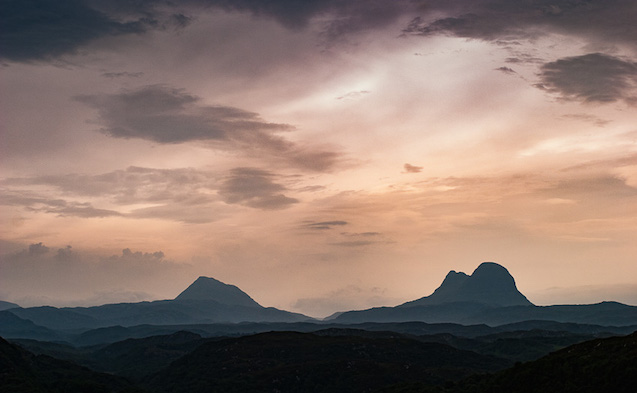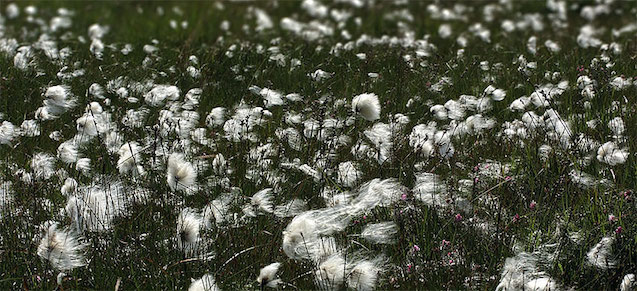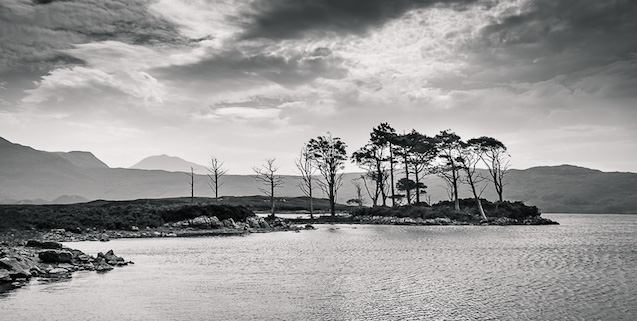Nick Thomas kicks off our birthday edition with a day on the water
I was already awake when the alarm clock went off. There’s not much night in the far northwest of Scotland in the summer and the sun shining through the blinds had woken me early. The alarm was shortly followed by a nudge in the back from my wife. “Time to get up if you’re going fishing today”.
I parted the blinds and looked outside. Dawn greeted me with dense patches of mist hanging in the folds and hollows among the heather outside the bedroom window. Our holiday cottage was huddled into the hillside overlooking the sea to the north of Achmelvich. A pristine white sandy inlet below, reached down a steep path past an old ruined watermill, gave us our own private bathing beach. The surrounding rock ledges falling into deep blue water over the silver sand were ideal for family fishing sessions in the evenings. Casting towards the lowering sun brought plenty of pollack, mackerel and the odd sea trout to our spinners to be carried back up through the rocks and heather to the barbecue.
The day had dawned with a clear sky and still air, not ideal for fishing, but unfortunately ideal for midgies. Outside the Terminator was hopefully doing his job. Not an Austrian accented cyborg, but an ingenious trap powered by a propane gas cylinder that emits a plume of carbon dioxide and other attractants which fool the little bastards that there’s a cow or a group of sheep grazing among the heather. Clouds of midgies were lifting from the ground and heading like smoke flowing in reverse towards the open chimney of the trap. Once inside they would be trapped in a fine mesh bag, later to be emptied in large piles of desiccated corpses. A million midgies weigh about a pound and our daily harvest regularly exceeded two pounds. Sounds like a lot, but bear in mind that under good conditions, or bad conditions, depending on your point of view, there can be over 100,000 lurking midgies in every square metre of damp heather
As the sun rose higher in the sky an intermittent breeze began to blow from the west moving the heather around, driving off the midgies and bringing some high cloud with it. Maybe it was going to be a decent day for fishing after all.
I was travelling light; my 3wt rod in its tube tucked down the side of my rucksack, a small net clipped to one of the shoulder straps, a reel, a spool of tippet and a small box of dry and wet flies completed the fishing gear for the day. The OS map and compass, a bottle of water, a couple of bridies from the bakery in Lochinver and a bottle of Skin so Soft completed my preparations in case the breeze faded later in the day.
That last item is an essential item for anyone wanting to retain their sanity when venturing outdoors in this part of Scotland in the summer. I wasn’t aware of the miraculous properties of this perfumed oily unguent until visiting the chandlers in Lochinver one day many years ago and asking why they had crates of the stuff stacked up by the door. Producing a pink bottle of skin care lotion from your rucksack may raise an eyebrow or two among the uninitiated, but it really does keep the midgies away and prevents you being driven to screaming jabbering madness and fleeing the hills as if pursued by creatures from hell. Which indeed you are. For me it works much better than DEET based repellents and has the distinct advantage of not leaving your fingerprints indelibly etched into your sunglasses, camera or anything else made of plastic that you touch.
The plan for the day was to walk a long circular route through the hills fishing wherever took my fancy. My ticket from the Assynt Crofters’ Trust gave me unfettered access to the myriad of lochs and lochans across the wide peninsular between Enard and Eddrachillis bays. More than enough scope for a day’s fishing. Enough for a lifetime probably. I learned to fly fish on these lochs on holidays with my parents 50 odd years ago and have returned many times. Sometimes alone, sometimes with company, but always being drawn back to one of the most dramatic and beautiful places on earth. I’ve been lucky enough to fish some fantastic waters in the US, Canada and Iceland, but I’d swap them all for Assynt. If there’s a breeze that is.

I crossed the narrow twisting single-track coast road and headed up a crofters’ peat track towards the first of the array of lochans that fill the hollows among the rock and heather. Looking back, the peaks of Suilven and Canisp loomed out of the last of the mist like the prows of massive sandstone ships sailing across the waves of an ancient ocean of 3 billion-year-old Lewisian gneiss.
I knew from many previous visits that the fish and the fishing in these lochs can be highly variable. Some lochans have no fish at all, some have loads of small eager trout and some have just a few fish, but of a higher than average size. Sometimes the likely trout population can be predicted from viewing the water, often it cannot. A stream to scour away the peat and expose some gravel and provide fresh oxygenated water to sustain a spawning population is always a good start.
Food supply is the main factor determining angling prospects. The water in most of these lochs and lochans is stained golden brown from the surrounding peat, acidic and low in minerals; not ideal for supporting a rich diversity of insect life. No fertile chalk-spring fed water teeming with fly life here. The surrounding land is low in life supporting minerals as evidenced by the abundance of carnivorous plants. Butterwort and Sundew grow everywhere around the lochs wherever the ground is boggy and they can attract enough insects to their sticky secretions to be trapped and slowly digested. At least they give some solace to the midgie bothered angler that something might eat a few of the little pests.
Given these conditions any trout with ambitions to grow to any reasonable size to challenge the rod of a passing angler will be reliant either on terrestrial insects that have avoided the greedy plants or on higher forms of aquatic life. Frogs and newts breed in the shallow margins of many of the lochans and their eggs and sometimes themselves add to the potential menu of hungry trout. A large deer hair sedge with a bright yellow underside is a popular fly in these parts, pulled across the surface of the dark pools to imitate an unwise frog or newt swimming in open water. There is of course another way that small trout can become big trout. Eating smaller trout. For them something dark and flashy pulled just under the surface is the order of the day.
After a mile or so I came to the first couple of lochans that I had planned to fish, cradled in glacial gouges and fringed with stunted alder and willow. A pair of Oystercatchers wheeled overhead calling to each other as I sat on a convenient mossy boulder, threaded up the rod and tied on my cast. A darkish bushy Sedgehog went on the dropper and a lightly weighted Black and Peacock spider with a red tag on the point. A quick dab of Gink on the Sedgehog and I was ready to go.
The first lochan was shallow at one end and choked with reeds and waterlilies, but after scrambling over some lichen covered rocks the banks steepened and I had some likely looking water in front of me. I made a few casts with no response, moved along and continued searching the water. Cast and step, cast and step, then walk on. That’s the key for fishing these lochs; if at first you don’t succeed, move. There’s always more water to try. There’s a chance if you persist on one lochan the fish may decide to cooperate, or they might not. So, moving on is always the best option; the grass is always greener and all that.
The second lochan of the pair looked pretty much the same, so my hopes weren’t rising too high as my flies dropped onto the water. A swirl and a jabbing tug signalled a fish. It wasn’t going to trouble the net, but the first fish of the day is always welcome, no matter what the size and this one was feisty and finely spotted. The second cast produced the same result and the third cast increased the average return with a fish on both flies. They were pretty much identical in size and markings, like close relatives, which they probably were. I moved along the bank to see if there were any larger, older members of the clan around. There weren’t. It was pleasant fishing, catching a fish every few casts, but with a long day ahead of me, it was time to move on.

I wound my way on eastwards, circuiting squelchy bogs of sphagnum moss and cotton grass shaking and shining in the breeze. Some of the lochs I cast across produced fish, some did not. Sometime late in the morning, I climbed up onto a rocky ridge and sat down to eat my lunch in the sun looking west over wild empty beauty, dotted everywhere I gazed with sparkling water.
I fished on through the long sultry afternoon, oblivious of the passing time, pausing now and then on a vantage spot to just sit and take in the isolation and the silence. I lost count of how many lochans I fished and how many fish took my flies. Circling back towards the west I came to an enchanting jewel-like lochan tucked into a fold in the heather. A small sandy beach looked out to an island topped with small Scots pines, looking for all the world like a collection of prize bonsai trees, growing protected from grazing sheep and deer. It was just too stunning to pass on by.
I slipped off my boots and socks and waded out over the sand, casting towards the rocks surrounding the island. The first cast was intercepted in a gentle rise of expanding ripples on the flat calm water. The subsequent jagging pull on the line as I raised the rod was not so gentle, this was a decent fish. After some splashy acrobatic resistance, the fish calmed down and was brought to hand shining golden brown and red-spotted. Quickly measured against the rod at about 12 inches, it was a big fish for such a tiny loch and every bit as beautiful as its home, to which it was swiftly returned.
I didn’t feel like to spoiling the moment by fishing the lochan anymore, so I lay on my back on the soft warm sand watching an eagle riding the thermals over the rocky ridge to the east. For an hour or so I was content just to be still and at peace, thinking how lucky I was to be where I was, doing what I was. Eventually I roused myself from this pleasant but rather self-indulgent reverie and for the first time that day, looked at my watch. It was getting late. Time to make my way back.

The sun was getting low in the sky as I approached the final hill separating me from the cottage. I could either follow the remains of an old wall up and over the ridge and descend to a much-needed cold beer, or follow a small stream down a gully to a tiny lochan I remembered fishing many years ago. Even though the breeze had now dropped and the midgies were beginning to make themselves felt, the prospects of a last few casts won.
As I approached the small lochan there was no sign of either insect or amphibian life and the sombre water seemed totally devoid of any indications of holding fish. Looks can be deceiving in these parts however. Some very dour looking waters can hold surprisingly large fish, some of them are the legacy of relocation of fish from other lochans. It’s a long tradition among anglers wandering in the far north on finding a loch with lots of small fish, with just next door, another with few or no fish, to practice a bit of catch and release with a short walk between the two events. Some regular anglers will have several of these stocked lochans which they keep as closely guarded secrets. These will be visited from year to year in the hope that some of their transplants, now with more space and less competition for food, will have grown on to large specimens, waiting and eager to take for a fly cast onto apparently unpromising water.
I remembered the local adage of stripping a bright sedge to attract newt-eaters. A quick rummage through the fly box revealed that I didn’t have one. Then I spotted, lurking on the back of the centre leaf, an old and forlorn looking olive and yellow foam beetle. This tattered veteran was quickly tied onto a single fly cast and pitched next to some rocks falling steeply into the whisky coloured depths. A couple of twitches of the fly were met with a large bow wave, a swirl on the surface and a savage pull on the line, taking me completely by surprise. The fish had hooked itself in its enthusiasm for a late evening snack of newt and was now boring down into the inky depths of the lochan. The Loop 3wt was protesting as it hooped over under the pull of what was obviously a much larger fish than it had been accustomed to handling that day. After such a calm and peaceful day, I was now anything but calm and peaceful and was oblivious to anything but landing this fish. Even the swarming midgies were ignored.
The fish continue to twist and turn, pulling off line against the drag as it tried to gain refuge amongst the huge boulders along the edge of the water. It pulled down and I pulled back, up and sideways in between swapping the rod from hand to hand to wipe sweat, slippery skin lotion and tiny midgie corpses out of my eyes. So much for the peace and quiet of the contemplative angler.
Eventually a large trout came to the surface and proceeded to swim round in intersecting loops, all the time balefully staring me out with one eye or the other and chomping on the foam beetle as if chiding me for denying it the promise of a decent newt supper. I tightened the drag slightly and praying that the hook would hold, arced the rod behind me to draw the fish towards my outstretched net.
As it slipped over the rim it dawned on me that it was bigger than the net by a good many inches, making it well over four pounds, maybe even over five. Not a huge fish for a stocked stillwater, or even a wild fish from a highly fertile chalk stream. But here? In a tiny lochan not much bigger than a suburban garden, with nothing to eat but the occasional drowned fly or wayward newt? This was an enormous trout. A memory to savour for ever. The fitting end to a dream day.
With the fish safely landed and the light dimmed beyond any chance of a photograph, I wanted to quickly unhook and return it before I was totally covered in midgie bites. I quickly pulled some line off the reel making the ratchet of the little Abel buzz. It didn’t sound right. Too strident. Too insistent. More like an alarm clock than a reel. I became aware of a persistent voice and a prodding in my back. “Time to get up if you’re going to fishing today”.

I wrote this story especially for the 6th birthday edition of ESF and I hope readers will forgive a semi-fictionalised account of fishing in one of my favourite places on earth. All the fishing locations described exist. All the events described happened to me while fishing in the far north-west over the past few years; but not necessarily on the same day. And that huge trout? It may still be there. If you want to find out get yourself a copy of OS Sheet 442, the 1:25000 scale map of Assynt & Lochinver and go fishing. You won’t regret it and you might have a dream day of your own.
Nick Thomas lives in South Wales. He started fly fishing on Scottish hill lochs many years ago and continues to design, tie and fish flies for trout, grayling, carp, bass and anything else that’s going.